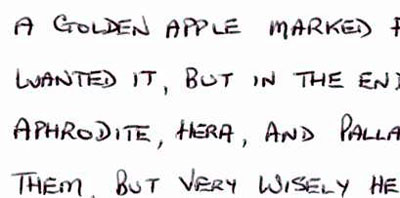“Graphology sounds interesting…..but what can you use it for?”
After analysing a sample of handwriting, the Graphologist can offer advice on personnel selection and employment screening, vocational guidance, compatibility between business partners and romantic partners, criminal activities such as poison pen letters forgeries and questioned signatures etc.
Can anyone learn how to analyse handwriting?
Yes. To become an expert, experienced and professional Graphologist requires a fascination for handwriting, patience, motivation and dedication.
But my handwriting changes depending on what I am writing…
Handwriting reflects your personality at the time of writing. Just as your facial expressions change depending on your mood, so does your handwriting. However, there are still basic characteristics which remain constant despite these minor variations.
Can you tell the writer’s sex from a sample of handwriting?
No, although handwriting does often have the appearance of being either ‘feminine’ or ‘masculine’
Does writing change with age?
Since writing reflects the writer’s state of mind at the time of writing, it would be strange if the person’s handwriting did not reflect signs of maturity and psychological development as the person ages. Infirmity with increased age will also affect the writer’s ability to write smoothly and fluently.
Can the potential for violence be seen in handwriting?
Very often yes – Graphologists refer to ‘red flags’ which can be easily detected in the writing and can reveal whether the writer has violent tendencies.
Can you tell what kind of work the writer is employed in from his/her handwriting?
No – this does not usually reveal itself, although very often the potential for what he or she can do is revealed. Artistic or musical talents may be symbolically revealed in the letter structures.
Can handwriting analysis reveal the future?
No.
Can handwriting analysis reveal what makes us tick?
Yes definitely.
Can graphologists analyse printscript and blocked capitals?
 Yes – printstyle writing, like cursive script, has strokes in all three zones (upper, middle, lower) but block printing (see below) is limited to the middle zone (with no “tails” below the baseline or strokes rising above the middle zone).
Yes – printstyle writing, like cursive script, has strokes in all three zones (upper, middle, lower) but block printing (see below) is limited to the middle zone (with no “tails” below the baseline or strokes rising above the middle zone).
Analysing printed writing presents more of a challenge than cursive script but, using the basic principles of graphology, slant, layout, pressure etc provide a wealth of information.
Is there such a thing as good or bad handwriting?
No. When a person’s handwriting deviates from the school copybook he or she was originally taught, it means the writer is developing his/her own individuality. Individuality itself can be ‘good’ or ‘bad’. A graphologist would have to look at what else there is in the handwriting to assess the overall character of the writer.
Is there a question we haven’t answered?
Why not send your question to enquiries@csog.org and we will get back to you as soon as possible.
